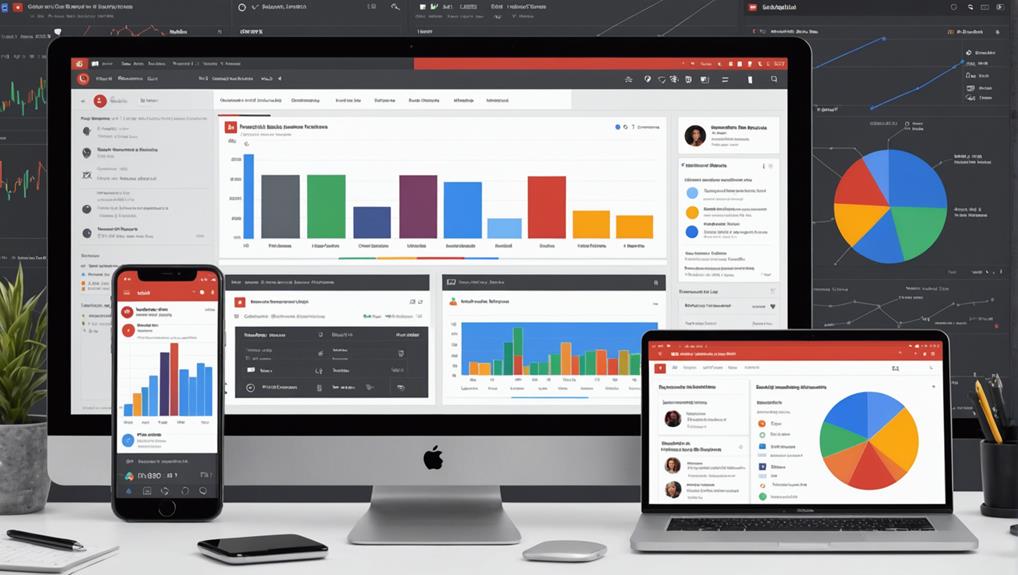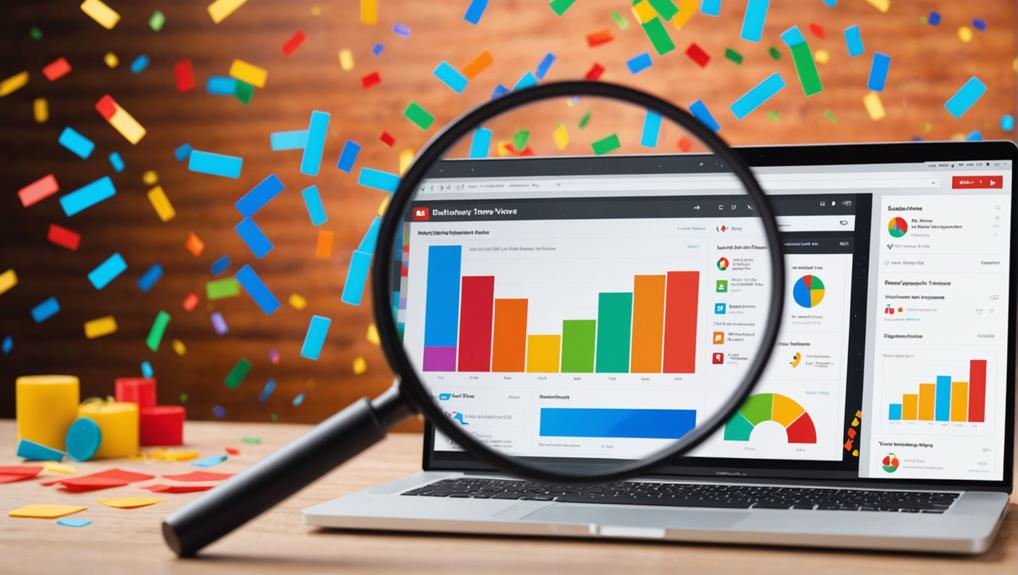Using real-time analytics allows you to instantly process and analyze data as it streams in, helping you make quick, informed decisions. By leveraging platforms like Apache Kafka and Google Pub/Sub, you can reduce query latency and react to market trends swiftly. This approach enhances operational efficiency and offers immediate insights, enabling you to adjust strategies proactively. The retail sector, financial institutions, and hotel chains are prime examples of industries benefiting from real-time analytics for pricing, inventory, and security management. Implementing robust data ingestion tools and security measures is critical. Explore further to understand the full potential and applications.
Key Takeaways
- Immediate Insights: Real-time analytics provides instant insights, enabling organizations to make quick strategic adjustments in response to current market trends.
- Proactive Decision-Making: It allows companies to anticipate and react to emerging trends before competitors, gaining a significant market advantage.
- Enhanced Customer Engagement: Organizations can tailor marketing campaigns and offers in real-time to meet changing customer demands and preferences.
- Operational Efficiency: Real-time data helps optimize operations by identifying inefficiencies and adjusting processes swiftly to improve overall performance.
- Security Threat Detection: Continuous monitoring of data streams enables rapid identification and response to security threats, minimizing potential impacts.
Understanding Real-Time Analytics
Understanding real-time analytics involves delving into the processes that allow data to be analyzed within seconds for immediate insights. At its core, real-time analytics hinges on data streaming and real-time processing.
Data streaming is the continuous flow of data generated by various sources, such as social media feeds, sensor networks, and financial transactions. This data is ingested, processed, and analyzed almost instantaneously.
You'll find that real-time processing is an essential component, enabling the immediate analysis of data as it arrives. This means that data freshness is paramount; the information you analyze is as current as possible, ensuring that your insights are always relevant.
Alongside this, low query latency is critical for rapid decision-making. When you query data, the system must respond in milliseconds to be considered real-time.
Platforms like Apache Kafka and Google Pub/Sub play a pivotal role in this ecosystem. They capture and manage data streams, ensuring high throughput and fault tolerance. These platforms handle high query complexity, allowing you to perform intricate analyses without significant delays.
Benefits of Real-Time Data
You can greatly improve your decision-making process with real-time data by accessing immediate insights. This quick access allows you to adjust your strategies promptly, leading to better responses to emerging market trends.
Leveraging real-time analytics, you gain enhanced market insights, enabling you to identify opportunities and threats as they arise.
Instant Decision Making
Real-time analytics greatly enhances instant decision-making by processing data within seconds, providing essential insights for rapid responses to emerging trends. When you leverage real-time data, you gain a significant edge, allowing for quick responses to market changes. This vital insight is essential for maintaining a competitive advantage and ensuring agility in your decision-making processes.
Immediate access to up-to-date information lets you proactively address emerging trends, optimizing your strategies for maximum impact. Imagine being able to adjust your marketing campaign on the fly because you noticed a sudden shift in consumer behavior. That's the power of real-time analytics.
You can capitalize on trends as they unfold, driving operational efficiency and staying ahead of the competition.
Enhanced Market Insights
Leveraging real-time data analytics uncovers nuanced market insights, enabling businesses to react swiftly and effectively to dynamic market conditions. By accessing up-to-date information, you can gain a competitive advantage by identifying and capitalizing on emerging market trends before your competitors. This proactive stance allows for timely strategic adjustments, ensuring your business stays relevant and responsive.
Real-time analytics empowers you to monitor customer behavior continuously. This means you can detect shifts in preferences or purchasing patterns as they happen, allowing you to tailor your offerings and marketing strategies accordingly. The ability to make these adjustments rapidly is essential for maintaining customer satisfaction and loyalty.
Here are three key benefits of utilizing real-time data for enhanced market insights:
- Immediate Response: Quickly adapt to market trends and customer behavior changes, giving your business a competitive edge.
- Strategic Adjustments: Make informed decisions on marketing and operational strategies based on the latest data.
- Opportunity Capitalization: Identify and seize new market opportunities as they arise, optimizing your strategies for maximum impact.
Real-Time Vs. Near-Real-Time Analysis
You'll find that real-time analysis processes data instantaneously, enabling immediate decision-making, whereas near-real-time analysis involves a slight delay.
This latency can impact how quickly you respond to trends, which is vital in time-sensitive industries like finance.
Both methods, however, provide faster responses than traditional data analysis, ensuring your business remains agile.
Data Processing Speed
When comparing data processing speeds, it's essential to understand how real-time analysis provides instantaneous insights, while near-real-time analysis offers a slight but impactful delay. Real-time analysis excels in scenarios requiring immediate reactions to trends due to its minimal data latency. This means you can act on insights as they emerge without waiting for data to process.
Near-real-time analysis, on the other hand, processes data with a minor delay, typically within minutes or hours. While this slight data latency might seem negligible, it can influence how quickly you respond to trends, especially in fast-paced environments.
To illustrate the differences in processing efficiency between real-time and near-real-time analysis, consider the following:
- Immediate Feedback: Real-time analysis provides data with virtually no delay, allowing for prompt actions.
- Slight Delay: Near-real-time analysis offers timely insights but includes a minor delay that could impact rapid decision-making.
- Operational Impact: The choice between real-time and near-real-time analysis can have a significant effect on how quickly you adapt to emerging trends.
Immediate Decision Making
Integrating real-time analytics into your decision-making process guarantees you can act swiftly on emerging trends with minimal data latency. When you process data instantaneously, you get immediate insights, enabling immediate reaction to changing market trends and customer behavior. This ability to react promptly is vital for maintaining an agile response strategy, especially in dynamic environments.
Comparing real-time analytics to near-real-time analysis, the latter involves a slight delay but still provides timely information for making informed decisions. While both methods empower you to stay responsive, real-time analytics offers a more proactive approach. Here's a quick comparison:
| Aspect | Real-Time Analysis | Near-Real-Time Analysis |
|---|---|---|
| Data Latency | Minimal | Slight delay |
| Decision Speed | Immediate reaction | Quick, but not instantaneous |
| Agility | High, suitable for dynamic environments | Moderate, balances speed with data processing |
Utilizing real-time analytics ensures your business can adapt on the fly, making you more competitive. Meanwhile, near-real-time analysis strikes a balance, providing slightly delayed but still actionable insights. Both strategies enhance your agility, but real-time analytics stands out for its capacity to drive immediate reactions, essential in rapidly shifting markets.
Latency Impact Analysis
Evaluating the latency impact between real-time and near-real-time analytics reveals critical differences in how swiftly businesses can react to market trends. Real-time analytics processes data instantaneously, typically within seconds, providing you with the ability to respond to emerging trends almost immediately.
In contrast, near-real-time analysis involves slight delays, ranging from minutes to hours, which can impact your decision speed.
To understand the practical implications, let's break down the latency comparison:
- Response Time: Real-time analytics offers a response time that's almost immediate, enabling you to make split-second decisions. Near-real-time analytics, on the other hand, introduces a lag that can delay your reaction to market changes.
- Agility Evaluation: With real-time analytics, your business gains a higher level of agility. Quick access to data means you can adapt faster to new information. Near-real-time analytics still allows for timely decisions, but with reduced agility due to the latency.
- Industry Relevance: For time-sensitive sectors like finance and e-commerce, where every second counts, real-time analytics is indispensable. However, near-real-time analysis can still be valuable for industries where slight delays are acceptable.
Understanding these differences helps you choose the right strategy for your business needs.
Key Applications in Various Industries
Retailers, financial institutions, hotel chains, and various other sectors harness the power of real-time analytics to make data-driven decisions that enhance operational efficiency and competitive edge. In retail, industry-specific applications include adjusting pricing strategies based on demand fluctuations, competitor activities, and inventory levels. Real-time trend monitoring enables retailers to react instantly to market changes, optimizing sales and inventory turnover.
Financial institutions rely on real-time analytics to make rapid trading decisions. By analyzing stock market trends and market data in real-time, they can execute trades more effectively and reduce financial risks.
Hotel chains utilize real-time analytics to dynamically adjust room pricing. Monitoring demand spikes and competitor pricing changes allows them to maximize occupancy rates and revenue.
Across various sectors, organizations use real-time analytics to detect and respond to security threats and anomalies swiftly. This proactive approach minimizes potential damages and ensures system integrity. Moreover, the integration of artificial intelligence with real-time analytics enhances customer engagement by delivering personalized recommendations and targeted marketing strategies, driving sales and customer loyalty.
Here's a quick overview of industry-specific applications and their benefits:
| Industry | Real-Time Applications | Benefits |
|---|---|---|
| Retail | Dynamic pricing, inventory management | Optimized sales, reduced stockouts |
| Financial | Rapid trading decisions | Increased trade effectiveness, reduced risks |
| Hospitality | Dynamic room pricing | Maximized occupancy, increased revenue |
| Cybersecurity | Threat detection and response | Minimized damages, ensured system integrity |
| Marketing | Personalized recommendations | Enhanced customer engagement, driven sales |
Steps to Implement Real-Time Analytics
To successfully implement real-time analytics, you must first define clear objectives and key metrics to track and measure progress. Establishing these parameters guarantees you're focused on the right goals and can evaluate the effectiveness of your implementation strategies.
Next, assess your data quality and sources. Reliable, accurate data is critical for real-time analytics, so you need to verify the integrity and consistency of your data sources. Implementing data visualization techniques can help you quickly identify and address any anomalies or inconsistencies.
Follow these steps to streamline your real-time analytics implementation:
- Select Efficient Data Ingestion Tools: Choose tools such as Apache Kafka or Google Pub/Sub to manage data flow. These tools ensure that data is ingested and processed efficiently, facilitating timely insights.
- Develop a Data Analysis Strategy: Outline your analysis goals and the methods you'll use to achieve them. This strategy will guide your real-time decision-making and ensure that your analytics efforts are aligned with your business objectives.
- Secure Data Collection and Processing: Implement robust security measures to protect your data. Secure data handling is essential to maintain trust and comply with regulatory requirements.
Tools for Real-Time Data
Choosing the correct tools for real-time data is essential to guarantee your analytics infrastructure can handle high-throughput data ingestion and processing efficiently.
Apache Kafka stands out as a robust solution for data streaming, known for its ability to manage large volumes of data with low latency. It's designed for scalability, enabling you to add or remove brokers dynamically to meet your data processing demands.
Google Pub/Sub offers a fully managed messaging service that excels in real-time analytics. Its scalability options are seamless, ensuring your data flow remains constant regardless of the volume. This makes it an excellent choice for applications requiring high reliability and low operational overhead.
Amazon Kinesis takes a holistic approach, supporting multiple data sources and stream processing applications. Its real-time data processing capabilities allow you to build sophisticated, scalable analytics applications quickly. You can efficiently handle the ingestion, processing, and storage of streaming data.
ClickHouse is a columnar database optimized for low-latency querying, making it perfect for real-time analytics. Its architecture is designed to support rapid data retrieval, ensuring your queries run efficiently even under heavy load.
To facilitate communication between databases and applications, frameworks like FastAPI and Express.js offer real-time API capabilities, ensuring seamless data streaming and integration.
Overcoming Challenges in Real-Time Analysis
Addressing the myriad challenges in real-time analysis demands a meticulous approach to data quality, scalability, and security, guaranteeing your analytics remain accurate and actionable.
First, data quality is paramount. You must implement robust data governance policies to continuously clean and validate incoming data. Without meticulous data quality control, your real-time analysis can lead to erroneous insights.
Second, scalability is a critical concern. As your data streams grow, you need a scalable infrastructure that can handle large volumes of data efficiently. This means investing in advanced tools and technologies that can process data at high speeds to deliver near real-time insights.
Third, ensuring the security and privacy of your data is non-negotiable. Implementing rigorous security measures protects sensitive information from cyber threats. This includes encryption, access controls, and regular security audits to maintain data integrity.
Here's a quick recap:
- Data Governance: Implement robust policies for data cleaning and validation.
- Scalability: Invest in advanced technologies to handle growing data volumes.
- Security Measures: Guarantee rigorous security protocols to protect sensitive data.
Frequently Asked Questions
What Analytics Are Used to Analyze Trends and Patterns Over Time?
To analyze trends and patterns over time, you use predictive modeling techniques like ARIMA and LSTM. Sentiment analysis also helps by interpreting emotional tones in data, providing deeper insights into trends and patterns in your datasets.
How Can Analytics Be Used in Real-Time?
You can use real-time analytics by employing predictive modeling and data visualization tools. These help you anticipate future trends and make informed decisions instantly, ensuring you're always ahead of market shifts and customer behavior changes.
Which Type of Analytics Can Be Used to Adjust to Trends in Customer Behavior?
You can use predictive modeling and sentiment analysis to adjust to trends in customer behavior. Predictive modeling forecasts future customer actions, while sentiment analysis evaluates customer opinions, helping you make data-driven decisions quickly.
How Will You Leverage Data Analytics?
You'll leverage data analytics by using predictive modeling to forecast trends and data visualization to interpret insights quickly. This approach guarantees you can adjust strategies in real-time and maintain a competitive edge in the market.
Conclusion
By leveraging real-time analytics, you can swiftly adapt to emerging trends and make informed decisions. Real-time data offers unparalleled benefits over near-real-time analysis, providing immediate insights essential for staying competitive.
Implementing these tools across various industries guarantees you're always a step ahead. Despite challenges, overcoming them with the right strategies will maximize your data's potential.
Ultimately, integrating real-time analytics into your operations is vital for sustained growth and efficiency.




